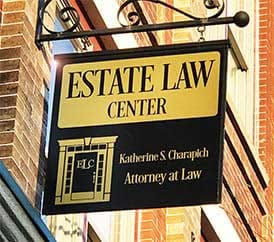Everything in it’s Proper Place
By Attorney Katherine S. Breckenridge, Esq.
Published January 11, 2018 – Culpeper Times
Estate Planning : Transfer on Death Deed
She admitted to standing in front of the refrigerator, attempting to place pantry goods into the icebox, and then quickly looking around to see if anyone had witnessed her mistake. The husband did not miss a beat and stated, “And, when she’s not looking, I quietly return everything to their proper places.” Sounds like a Hallmark moment; for that spouse, I am sure it was, and gave great reason to be thankful.
Perhaps at the turn of the new year, or a change in a season of life, you have been aware of a need to put your estate planning matters in order, but just did not know the options. With possible changes over the years, have you wondered if there are estate planning choices that you had not yet considered?
When discussing such heartfelt matters as planning for one’s care, and the use and distribution of assets, I, for one, need reminders of thankfulness, as earthly limits are ever present in my area of the Law – the discussion of death, the planning for it, and its occurrence.
The enormity of it – weighty, seemingly formidable. With it, come moments of such utter sadness, indescribable puzzlement, interwoven relationships, exhaustion, revelations of quiet joy and understanding, and glimpses of unparalleled strength and courage. How does one keep death in perspective? Perhaps it is Faith “. . . the substance of things hoped for, the evidence of things not seen.” (Hebrews 11:1 KJV)
Faith – and the assurance of being prepared, can bring one a comfort that is hard to express through words.
Recently, embodied in a client’s actions, I was witness to the evidence of things not seen. He arrived almost unrecognizable from an earlier meeting; having lost the will to live, he had given up eating and drinking. As the treasured one left my office, amidst the hugs and well wishes – he grabbed my hands and gave me a “knowing look.” I have seen that look before – it breaks my heart. It is one of final preparation – a farewell.
This dear friend had prepared well for such a time of transition, using a transfer on death deed along with a last will and testament. A gift to beloved family members, who can now focus more on the celebration of his life, and less on the process of distributing assets.
The preparation seems like one of those “to-do” list items that too often, gets bumped down the list. While you can still find humor in the placing of pantry items into the icebox, misplacing your phone for the third time in one day, or calling your child by your dog’s name, resolve to inch that estate planning up the priority list.
With some relatively recent changes, some of the available tools may surprise you. For example, there are sensible ways to transfer assets outside of probate. In July of 2013, the Virginia General Assembly, through the Uniform Real Property Transfer on Death Deed Act, made available the transfer on death deed. A transfer on death deed applies to interests owned in real property, which means real estate, both raw land and land with improvement. The recordation of such a deed allows for the transfer of any interest owned in the real property to a beneficiary upon your passing without the real property passing through probate.
Though the transferor of a transfer of death deed must have the same capacity as is required to make a will, a transfer on death deed is non-testamentary, meaning that it is not an interest created through a last will and testament. § 64.2-628 of the Code of Virginia (the Code) sets forth the requirements of such a deed, including that the deed “contain the essential elements and formalities of a properly recordable inter vivos deed.” The Code requires that the deed be recorded prior to the transferor’s death.
A transfer on death deed can name primary beneficiaries and contingent beneficiaries, and can even contain detailed per stirpes language. Consider a transfer on death deed as being a deed that in essence waits in the wings until the passing of the transferor. The transferor may have partial or full interest in the real property, yet having a transfer on death deed in place does not affect the ownership interest of the transferor during the transferor’s lifetime. She can encumber, sell, gift, or divide her interest without a restraint affected by the transfer on death deed. In correlation, according to §64.2-631 of the Code, a transfer on death deed does not “create a legal or equitable interest in favor of the designated beneficiary,” nor can a beneficiary lay claim to an anticipation of what may happen.
What if the transferor has a change of heart? The Code allows for the transferor to revoke the transfer on death deed, and if the transferor so chooses, can then record a new transfer on death deed.
Though comprehensive estate planning includes having a last will and testament in place, those who have also utilized a transfer on death deed have upon their passing, transferred their property outside of the probate process.
Whether it’s the anticipation of a new year or the prompting of a new season in life, having a discussion about what estate planning tools work best for your situation is worth checking off your to-do list, and breathing a sigh of relief!
Then, perhaps as you approach a new season, consider Jeremiah 29:11 (NIV), “For I know the plans I have for you,” declares the Lord, “plans to prosper you and not to harm you, plans to give you hope and a future.”
